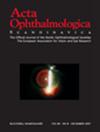Influence of age, baseline severity and follow-up time on visual field progression in primary open angle glaucoma
Abstract
Aims/Purpose: Challenges in modeling rates of visual field (VF) progression relate to flooring effects and sensitivity to inclusion criteria like follow-up (FU) duration. We explored the relationship between VF progression and age, disease severity, and FU duration in primary open angle glaucoma (POAG).
Methods: Mean Deviation (MD) of 655 POAG eyes of 424 patients from the UZ Leuven Glaucoma Clinic with at least 5 VFs and 2 years of follow-up were used. Baseline severity was defined as Above 0 (≥0dB), mild ( < 0 and ≥-6dB), moderate ( < -6 and ≥-12dB), advanced ( < -12 and ≥-15dB), and severe ( < -15dB) disease. Linear mixed models and changepoint detection were used. Sensitivity analysis of modeled progression rates within each severity group was done by varying maximally included duration of FU.
Results: MD progression rates per year were -0.34dB (p < 0.001) for Above 0, -0.49dB (p < 0.001) for mild, -0.49dB (p < 0.001) for moderate, -0.26dB (p = 0.009) for advanced, and +0.1dB (p = 0.317) for severe POAG. Random effects correlation between baseline MD and progression rates was 0.36. The fixed effects for age and test related learning effect were non-significant (p = 0.65) and -0.21 (p = 0.004) respectively. The correlation between the implied slope and baseline age was -0.26. Changepoint analysis showed that group level progression estimates stabilized when minimum FU times were at least 2.17, 1.99, 2.18, and 4.56 years for mild, moderate, advanced and severe POAG respectively.
Conclusions: Older patients progress faster across severity levels and a significant learning effect is present when excluding patients with severe POAG. Excluding patients with a baseline MD above 0dB, the modeled average MD change is similar between mild and moderate POAG. Less progression is observed in advanced and no progression in severe POAG, consistent with the flooring effect. In mild and moderate POAG patients progression estimates converged after a minimum FU of at least 2 years.

 求助内容:
求助内容: 应助结果提醒方式:
应助结果提醒方式:


